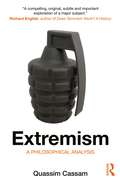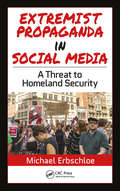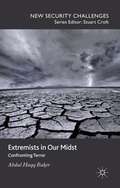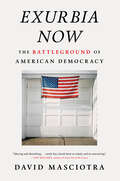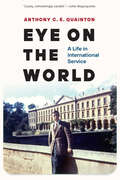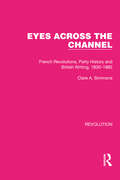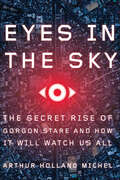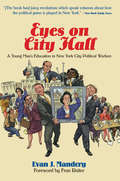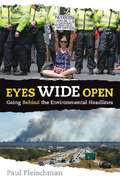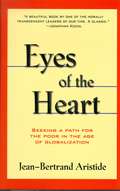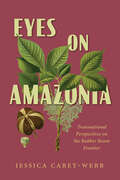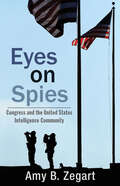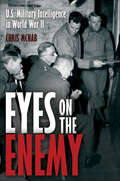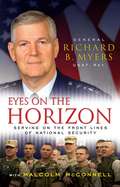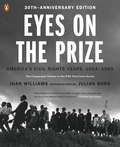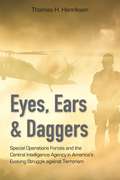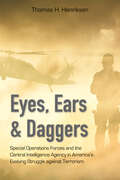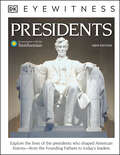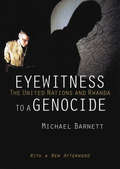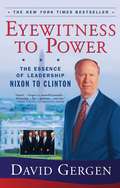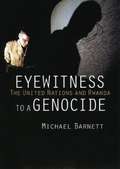- Table View
- List View
Extremism: A Philosophical Analysis
by Quassim CassamExtremism is one of the most charged and controversial issues of the twenty-first century. Despite myriad programs of deradicalization and prevention around the world, it remains an intractable and poorly understood problem. Yet it is also sometimes regarded as a positive force – according to Martin Luther King Jr., 'the question is not whether we will be extremists, but what kind of extremists we will be'. In this much-needed and lucid book, Quassim Cassam identifies three types of extremism – ideological; methods; and psychological extremism – and discusses the following fundamental topics and issues: What is extremism? What are the methods adopted by extremists? Is there an extremist ‘mindset’ and if so, what is it? What role do ideas of purity, victimhood and humiliation play in understanding extremism? How does extremism differ from fanaticism and fundamentalism? How does one become an extremist and how should we understand deradicalization? Throughout the book, Quassim Cassam uses many compelling examples, ranging from the Khmer Rouge, the IRA, Al-Qaeda and Timothy McVeigh to Philip Roth’s novel American Pastoral and counter-extremism programmes, including the UK’s Prevent strategy. Clear-headed and engaging, Extremism: A Philosophical Analysis is essential reading for anyone interested in this important topic, not only in Philosophy but related disciplines such as Politics and International Relations, Conflict and Terrorism Studies, Law, Education and Religion. It will also be of great interest to policy-makers and those engaged in understanding extremism at any level.
Extremist Propaganda in Social Media: A Threat to Homeland Security
by Michael ErbschloeExtremist Propaganda in Social Media: A Threat to Homeland Security presents both an analysis of the impact of propaganda in social media and the rise of extremism in mass society from technological and social perspectives. The book identifies the current phenomenon, what shall be dubbed for purposes of this book "Blisstopian Societies"—characterized in the abiding "ignorance is bliss" principle—whereby a population is complacent and has unquestioning acceptance of a social doctrine without challenge and introspection. In these subcultures, the malleable population self-select social media content, "news," and propaganda delivery mechanisms. By doing so, they expose themselves only to content that motivates, reinforces, and contributes to their isolation, alienation, and self-regulation of the social groups and individuals. In doing this, objective news is dismissed, fake—or news otherwise intended to misinform—reinforces their stereotyped beliefs about society and the world around them. This phenomenon is, unfortunately, not "fake news," but a real threat to which counterterror, intelligence, Homeland Security, law enforcement, the military, and global organizations must be hyper-vigilant of, now and into the foreseeable future. Chapters cite numerous examples from the 2016 political election, the Russia investigation into the Trump Campaign, ISIS, domestic US terrorists, among many other examples of extremist and radicalizing rhetoric. The book illustrates throughout that this contrived and manufactured bliss has fueled the rise and perpetuation of hate crimes, radicalism, and violence in such groups as ISIS, Boko Haram, Neo-Nazis, white separatists, and white supremacists in the United States—in addition to perpetuating ethnic cleansing actions around the world. This dynamic has led to increased political polarization in the United States and abroad, while furthering an unwillingness and inability to both compromise or see others’ perspectives—further fomenting insular populations increasing willing to harm others and do violence. Extremist Propaganda in Social Media relates current Blisstopian practices to real-world hate speech and violence, connecting how such information is consumed by groups and translated into violent action. The book is an invaluable resources for those professionals that require an awareness of social media radicalization including: social media strategists, law enforcement, Homeland Security professionals, military planners and operatives—anyone tasked with countering combat such violent factions and fringes in conflict situations.
Extremists in Our Midst
by Abdul Haqq BakerSince 9/11 and 7/7, the issue of violent radicalization has attracted wide-ranging research, policy and media focus. However, in the vast majority of accounts, the experiences and insights of individuals who have directly encountered extremists are missing. This book uses empirical data to explain the processes of violent radicalization and what effective counter-terrorism practice might involve. It examines the ways in which communities can play an important role in countering terrorism and explores wider issues of identity in relation to religion and nationality. Baker presents a case study analysis of three extremists who were convicted of terrorist related offences and consequently imprisoned, alongside the case study of a convert who was drawn towards violent extremism but moved away from this position. Written by an insider of a British Muslim convert community, it is part of an emerging wider trend of practitioner-led research.
Exurbia Now: The Battleground of American Democracy
by David MasciotraThe suburbs have become too liberal and diverse for many white American conservatives, so &“exurbia&”—areas outside the cities and their suburbs—are becoming the staging ground for the radical right extremist insurgency . . .Beyond a fanatical devotion to former president Donald Trump, one of the curious things that united the rank and file of the January 6 insurrectionist mob was that many of them were residents of one of America&’s fastest growing residential areas: Exurbia.Home to the likes of Georgia&’s Marjorie Taylor Greene, Ohio&’s Jim Jordan, big box retailers, chain restaurants, monster trucks, and megachurches, exurbia is becoming America&’s greatest political battleground, more important to American politics than urban or rural America. In this brilliant work of political and cultural inquiry, veteran political journalist David Masciotra provides a definitive account of what exurbia is, how it came to be, and how it's transforming American life. Zooming in outside the greater metropolitan area of Chicago—where Masciotra grew up—he shows how exurbia has become a safe space to fly the MAGA flag and romanticize the mores of the pre-civil rights, pre-feminist, pre-gay rights 1950s.But, as Masciotra also shows, reactionary white flight is not the whole story of small-town America. The story often lost is the power and persistence of small-town liberals—people who believe in equality, celebrate diversity, and enroll in movements for justice. Exurbia, as it turns out, is ground zero for the fight over a democracy mightily beleaguered, yet still full of promise, and still worth fighting for. Combining interviews, research, and anecdote—and anchored in personal experience—Exurbia Now delivers a powerful ballad on the state of small-town America, and provides a sense of the fight for democracy, on the ground, in the heartland.
Eye on the World: A Life in International Service
by Anthony C. QuaintonEye on the World is the autobiography of diplomat Anthony C. E. Quainton, the story of a long and varied life lived in eleven countries on six continents. Rather than a formal history, this is Quainton&’s reflection on his interactions with the events of those times, beginning with George VI&’s historic visit to North America in 1939, through the years of the Cold War, the efforts to contain and then defeat the Soviet Union, and finally the two decades of uneasy peace that came after the fall of the Berlin Wall. To some of these events Quainton was merely a spectator. In other areas––India, Nicaragua, Kuwait, and Peru––he was actively involved either as a participant in the policy process in Washington or as the senior representative of the United States in those countries. Spanning his upbringing and education through two decades after his retirement, Quainton describes the expanding horizons of a middle-class boy from the northwest corner of North America as he encountered the complexity of the world in which he spent his professional life. Quainton served in seven different presidential appointments under presidents Gerald Ford, Jimmy Carter, Ronald Reagan, George H. W. Bush, and Bill Clinton. These included four ambassadorships in distinct parts of the world and three assistant secretary–level posts in Washington. This range of geographic and functional assignments was unique in his generation of Foreign Service officers.
Eyes Across the Channel: French Revolutions, Party History and British Writing, 1830–1882 (Routledge Library Editions: Revolution #11)
by Clare A. SimmonsThis book, first published in 2000, uses interpretations of the French Revolution as a model to ask what history meant to Victorian Britain, how events became enshrined with the authority of history, and how such cultural assumptions might help us to read nineteenth-century British literature. By examining reactions to French revolution in a broad selection of texts, this book explores how the Victorians responded to developments in France in historical terms, repeatedly comparing new events to the touchstone of the first French Revolution, yet always with the goal of finding ways to understand Britain’s own past, present and future.
Eyes In The Sky: The Secret Rise of Gorgon Stare and How It Will Watch Us All
by Arthur Holland MichelThe fascinating history and unnerving future of high-tech aerial surveillance, from its secret military origins to its growing use on American citizensEyes in the Sky is the authoritative account of how the Pentagon secretly developed a godlike surveillance system for monitoring America's enemies overseas, and how it is now being used to watch us in our own backyards. Whereas a regular aerial camera can only capture a small patch of ground at any given time, this system—and its most powerful iteration, Gorgon Stare—allow operators to track thousands of moving targets at once, both forwards and backwards in time, across whole city-sized areas. When fused with big-data analysis techniques, this network can be used to watch everything simultaneously, and perhaps even predict attacks before they happen. In battle, Gorgon Stare and other systems like it have saved countless lives, but when this technology is deployed over American cities—as it already has been, extensively and largely in secret—it has the potential to become the most nightmarishly powerful visual surveillance system ever built. While it may well solve serious crimes and even help ease the traffic along your morning commute, it could also enable far more sinister and dangerous intrusions into our lives. This is closed-circuit television on steroids. Facebook in the heavens. Drawing on extensive access within the Pentagon and in the companies and government labs that developed these devices, Eyes in the Sky reveals how a top-secret team of mad scientists brought Gorgon Stare into existence, how it has come to pose an unprecedented threat to our privacy and freedom, and how we might still capitalize on its great promise while avoiding its many perils.
Eyes On City Hall: A Young Man's Education In New York City Political Warfare
by Evan ManderyThe Campaign is a close-up look at the paranoid, frenzied, oppressive, and exhilarating world of modern political campaigns?a universe where truth is fungible and moral conviction a mere asset, like good looks or personal wealth. Corporeal restraints do not exist. People regularly become things they are not.Evan Mandery, research director on Ruth Messinger's doomed challenge to Mayor Rudy Giuliani, offers a behind-the-scenes look at political campaigns in the television era. A day-to-day account of the 1997 New York City mayoral race, it takes us to the real battlegrounds of modern politics: polls, focus groups and television editing studios. With Mandery as our guide, we watch first-hand as political consultants, conceive of the ideal candidate and then attempt to fit their client into that ideal, no matter how uncomfortably.The stars of the story are memorable: Rudy Giuliani, popping his eyes and tweaking the truth; Al Sharpton, the colorful preacher and rising political force; and Ruth Messinger herself, torn between her populist political upbringing and the modern political world where money dominates over all other concerns. Sometimes cynical, often mirthful, and always honest, The Campaign will forever change your view of political campaigns.
Eyes Wide Open: Going Behind The Environmental Headlines
by Paul FleischmanWe're living in an Ah-Ha moment. Take 250 years of human ingenuity. Add abundant fossil fuels. The result: a population and lifestyle never before seen. The downsides weren't visible for centuries, but now they are. Suddenly everything needs rethinking - suburbs, cars, fast food, cheap prices. It's a changed world. <p><p> This book explains it. Not with isolated facts, but the principles driving attitudes and events, from vested interests to denial to big-country syndrome. Because money is as important as molecules in the environment, science is joined with politics, history, and psychology to provide the briefing needed to comprehend the 21st century. <p> Extensive back matter, including a glossary, bibliography, and index, as well as numerous references to websites, provides further resources.
Eyes of the Heart: Seeking a Path for the Poor in the Age of Globalization
by Jean-Bertrand AristideIn this startling and passionate book, Aristide demonstrates why those on the bottom will never lie down. A graphic revelation of what happens when "free" trade overruns local markets, eradicates local economies, and creates dependence on foreign charity.
Eyes on Amazonia: Transnational Perspectives on the Rubber Boom Frontier
by Jessica Carey-WebbThe Amazon extends across nine countries, encompasses forty percent of South America, and hosts four European languages and more than three hundred Indigenous languages and cultures. Eyes on Amazonia is a fascinating exploration of how Latin American, European, and US intellectuals imagined and represented the Amazon region during the late nineteenth and early twentieth centuries. This multifaceted study, which draws on a range of literary and nonliterary texts and visual sources, examines the complex ways that race, gender, mobility, empire, modernity, and personal identity have indelibly shaped how the region was and is seen. In doing so, the book argues that representations of the Amazon as a region in need of the civilizing influence of colonialism and modernization served to legitimize and justify imperial control.Eyes on Amazonia operates in cultural geography, ecocriticism, and visual cultural analysis. The diverse and intriguing documents and images examined in this book capture the modernizing project of this region at a crucial juncture in its long history: the early twentieth-century rubber boom.
Eyes on Spies: Congress and the United States Intelligence Community
by Amy B. ZegartAmy Zegart examines the weaknesses of US intelligence oversight and why those deficiencies have persisted, despite the unprecedented importance of intelligence in today's environment. She argues that many of the biggest oversight problems lie with Congress—the institution, not the parties or personalities—showing how Congress has collectively and persistently tied its own hands in overseeing intelligence.
Eyes on the Enemy: U.S. Military Intelligence in World War II
by Chris McNab"...a comprehensive reprint of the Intelligence doctrine that supported the American drive to victory on numerous fronts against a wide range of enemies and environments. It is worth the read to reinforce the basics of what we still do today." — The Vanguard: Journal of the Military Intelligence Corps Association On December 7, 1941, an imperial Japanese carrier strike force attacked the US Pacific Fleet at Pearl Harbor, taking advantage of what was one of the most profound intelligence failures in US history. Galvanized into action, the branches of the U.S. military subsequently developed one of the greatest, albeit imperfect, intelligence-gathering and analysis networks of the combatant nations, opening an invaluable window onto the intentions of their enemies. The picture of U.S. military intelligence during World War II is a complex one. It was divided between the fields of signal intelligence (SIGINT) and human intelligence (HUMINT), combat intelligence and War Department intelligence, and between numerous different organizations, including the Military Intelligence Division (MID), Military Intelligence Service (MIS), the Office of Naval Intelligence (ONI), the Counter Intelligence Corps (CIC), the Office of Strategic Services (OSS) and the many intelligence units organic to Army, Navy, Army Air Forces, and Marine Corps. The documents collected in this book reveal the theoretical and practical principles behind wartime intelligence gathering and analysis, from the frontline intelligence officer to the Washington-based code-breaker. They explain fundamentals such as how to observe and record enemy activity and intercept enemy radio traffic, through to specialist activities such as cryptanalysis, photoreconnaissance, prisoner interrogation, and undercover agent operations. The painstaking work of an intelligence operator required a sharp, attentive mind, whether working behind a desk or under fire on the frontlines. The outputs from these men and women could ultimately make the difference between victory and defeat in battle.
Eyes on the Horizon: Serving on the Front Lines of National Security
by Malcolm Mcconnell Richard MyersGeneral Richard B. Myers, Chairman of the Joint Chiefs of Staff during the critical four years following September 11, 2001, looks back over his career and provides a candid, revealing insider's view of the war on terror and proposing a bold new plan that will prepare America for the diverse national security challenges of the twenty-first century. Growing up in Kansas as the son of hardworking, no-nonsense parents, General Richard Myers, a distinguished Air Force officer for more than forty years, learned early the value of steadfast integrity and selfless service. As Chairman of the Joint Chiefs of Staff from 2001 to 2005, he bore witness to the critical events that shaped America's defense policy in the wake of the terrorist attacks of September 11, 2001. In the days, weeks, and months that followed, he worked around the clock, helping to devise innovative, unprecedented strategies for the Bush administration's war on terror in Afghanistan and Iraq and advising the president on tough, historic national security decisions. In this captivating memoir, General Myers talks candidly about his career in the military, the unforgettable events of September 11, and the global war on terror. With an insider's perspective, he outlines the mistakes made by the White House, Pentagon leadership, and the intelligence community. Myers believes that America has misidentified its adversary, focusing too narrowly on tactical battles, instead of on a long-range strategy that will overcome a global insurgency fueled by a struggle for control within Islam. The United States must rely not just on the military, but also on intelligence and other instruments of national power and work through extant governments to reverse the depiction of an American-led crusade against Muslims. Rather than identify what Islam should become, we must work with an international community that includes responsible non-Western states to protect against the behaviors we consider universally unacceptable -- especially those that promote violence against the U.S. and its allies or any other country or society affected by the struggle within Islam. Finally, Myers maintains we must integrate our own government agencies so that we can focus a sustained approach to this strategy. Told with unfailing honesty, Eyes on the Horizon is an unforgettable memoir of one of our nation's highest ranking officers and a courageous call for change that will strengthen American national security and defend a democratic way of life.
Eyes on the Prize: America's Civil Rights Years, 1954-1965
by Juan WilliamsThe 25th-anniversary edition of Juan Williams's celebrated account of the tumultuous early years of the civil rights movement From the Montgomery bus boycott to the Little Rock Nine to the Selma-Montgomery march, thousands of ordinary people who participated in the American civil rights movement; their stories are told in Eyes on the Prize. From leaders such as Martin Luther King, Jr. , to lesser-known figures such as Barbara Rose John and Jim Zwerg, each man and woman made the decision that somethinghad to be done to stop discrimination. These moving accounts and pictures of the first decade of the civil rights movement are a tribute to the people, black and white, who took part in the fight for justice and the struggle they endured. .
Eyes on the Prize: America's Civil Rights Years, 1954-1965
by Juan Williams Julian BondEyes on the Prize traces the movement from the landmark Brown v. the Board of Education case in 1954 to the march on Selma and the passage of the Voting Rights Act in 1965. This is a companion volume to the first part of the acclaimed PBS series.
Eyes on the Street: The Life of Jane Jacobs
by Robert KanigelThe first major biography of the irrepressible woman who changed the way we view and live in cities, and whose influence can still be felt in any discussion of urban planning to this day. Eyes on the Street is a revelation of the phenomenal woman who raised three children, wrote seven groundbreaking books, saved neighborhoods, stopped expressways, was arrested twice, and engaged at home and on the streets in thousands of debates--all of which she won. Here is the child who challenged her third-grade teacher; the high school poet; the journalist who honed her writing skills at Iron Age, Architectural Forum, Fortune, and other outlets, while amassing the knowledge she would draw upon to write her most famous book, The Death and Life of Great American Cities. Here, too, is the activist who helped lead an ultimately successful protest against Robert Moses's proposed expressway through her beloved Greenwich Village; and who, in order to keep her sons out of the Vietnam War, moved to Canada, where she became as well known and admired as she was in the United States.From the Hardcover edition.
Eyes, Ears & Daggers: Special Operations Forces and the Central Intelligence Agency in America's Evolving Struggle against Terrorism
by Thomas H. HenriksenThomas H. Henriksen examines the warrior-spy connection both before and after the formation of the SOF and the CIA. Henriksen shows how, by adopting an intelligence-driven, targeted counter strike weapon against terrorists, the United States went from a Cold War Goliath to a more nimble force, thanks largely to the SOF and CIA contributions.
Eyes, Ears, and Daggers: Special Operations Forces and the Central Intelligence Agency in America's Evolving Struggle against Terrorism
by Thomas H. HenriksenBoth the Special Operations Forces (SOF) and the Central Intelligence Agency (CIA) have served as the nation's eyes, ears, and daggers, often in close cooperation but occasionally at cross-purposes throughout their histories. In this book, Thomas H. Henriksen examines the warrior-spy connection both before and after the formation of the SOF and the CIA, suggesting that their history is notable for instances of cooperating, competing, circumventing, and even cutting each other out of the action before the 9/11 terrorist attacks brought about their present close alignment. Henriksen shows how, by adopting an intelligence-driven, targeted counterstrike weapon against terrorists, the United States went from a Cold War Goliath to a more nimble force, thanks largely to the SOF and CIA contributions. But their contemporary blending, he suggests, could be just a temporary realignment and that a return to their traditional rivalry is not out of the question. By revisiting and appreciating their respective histories before partnering to combat Islamist terrorism, he provides a clearer understanding of their interaction and offers lessons for the struggle against extremist violence.
Eyewitness Presidents (DK Eyewitness)
by DKAn informative and visual guide to America's highest office, this DK Eyewitness book explores the history of the White House and the presidents who have served in it.Written in association with the Smithsonian Institution, this beautiful visual reference book provides mini-biographies and trivia for budding historians, along with hundreds of photos that illustrate the lives of Presidents that shaped American history.Students and teachers alike will find intriguing facts in this comprehensive history book. Each president's feature starts with their early lives and takes the reader through their political careers. Discover how they came into office and what happened after they won their presidential elections. Be an eyewitness to the history of the inhabitants of the White House through full-color photographs of famous paintings, campaign memorabilia, handwritten letters, and even historical artifacts belonging to each President.As the first person to be called the President of the United States, George Washington helped unite the colonies and win independence from King George of Great Britain. Learn about his revolutionary leadership and the forging of the Constitution. Discover how Abraham Lincoln saved the Union from the American Civil War, and how Thomas Jefferson doubled the size of the nation with the Louisiana Purchase.The book includes a section of presidential speeches such as John F. Kennedy&’s inaugural address and Ronald Reagan's Evil Empire speech. Read about other 20th century presidents such George W. Bush, Bill Clinton, and the first Black president Barack Obama. This new edition introduces America&’s newest Commander-in-chief Joe Biden.The History of the US Presidents From George Washington to Joe BidenDK Eyewitness Books: Presidents uses a unique integrated format with text and pictures to give insight into the lives of the men that have held the highest position in the USA. Eyewitness educational books are a favorite for school-aged students, parents, and teachers alike.Inside this fascinating visual reference book: • Includes a feature on every American President in history - right up to Joe Biden • Presidential facts and trivia in bite-sized information that is easy to follow for younger readers • Hundreds of photos of famous artworks, historical artifacts, and handwritten letters • Includes a section on some of history's famous American political speeches More from DK Books:For more interesting facts about American Presidents look for DK Books The Presidents Visual Encyclopedia. If you enjoy DK Eyewitness Books: Presidents there are over 170 Eyewitness titles to choose from, covering a large variety of topics. For more history reference books DK Eyewitness: Victorians, DK Eyewitness: Aztec, and DK Eyewitness: World War I - just a few of the titles available.
Eyewitness To A Genocide
by Michael BarnettWhy was the UN a bystander during the Rwandan genocide? Do its sins of omission leave it morally responsible for the hundreds of thousands of dead? Michael Barnett, who worked at the U. S. Mission to the United Nations from 1993 to 1994, covered Rwanda for much of the genocide. Based on his first-hand experiences, archival work, and interviews with many key participants, he reconstructs the history of the UN's involvement in Rwanda. In the weeks leading up to the genocide, the author documents, the UN was increasingly aware or had good reason to suspect that Rwanda was a site of crimes against humanity. Yet it failed to act. Barnett argues that its indifference was driven not by incompetence or cynicism but rather by reasoned choices cradled by moral considerations. Employing a novel approach to ethics in practice and in relationship to international organizations, Barnett offers an unsettling possibility: the UN culture recast the ethical commitments of well-intentioned individuals, arresting any duty to aid at the outset of the genocide. Barnett argues that the UN bears some moral responsibility for the genocide. Particularly disturbing is his observation that not only did the UN violate its moral responsibilities, but also that many in New York believed that they were "doing the right thing" as they did so. Barnett addresses the ways in which the Rwandan genocide raises a warning about this age of humanitarianism and concludes by asking whether it is possible to build moral institutions.
Eyewitness to Power: The Essence of Leadership Nixon to Clinton
by David GergenFrom Nixon to Clinton, Watergate to Whitewater, few Americans have observed the ups and downs of presidential leadership more closely over the past thirty years than David Gergen. A White House adviser to four presidents, both Republican and Democrat, he offers a vivid, behind-the-scenes account of their struggles to exer- cise power and draws from them key lessons for leaders of the future. Gergen begins Eyewitness to Power with his reminiscence of being the thirty-year-old chief of the White House speechwriting team under Richard Nixon, a young man at the center of the Watergate storm. He analyzes what made Nixon strong-and then brought him crashing down: Why Nixon was the best global strategist among recent presidents. How others may gain his strategic sense. How Nixon allowed his presidency to spin out of control. Why the demons within destroyed him. What lessons there are in Nixon's disaster. Gergen recounts how President Ford recruited him to help shore up his White House as special counsel. Here Gergen considers: Why Ford is one of our most underrated presidents. Why his pardon of Nixon was right on the merits but was so mishandled that it cost him his presidency. Even in his brief tenure, Ford offers lessons of leadership for others, as Gergen explains. Though Gergen had worked in two campaigns against him, Ronald Reagan called him back to the White House again, where he served as the Gipper's first director of communications. Here he describes: How Reagan succeeded where others have failed. Why his temperament was more important than his intelligence. How he mastered relations with Congress and the press. The secrets of "the Great Communicator" and why his speeches were the most effective since those of John Kennedy and Franklin Roosevelt.
Eyewitness to Power: The Essence of Leadership Nixon to Clinton (G. K. Hall Core Ser.)
by David GergenFrom Nixon to Clinton, Watergate to Whitewater, few Americans have observed the ups and downs of presidential leadership more closely over the past thirty years than David Gergen. A White House adviser to four presidents, both Republican and Democrat, he offers a vivid, behind-the-scenes account of their struggles to exercise power and draws from them key lessons for leaders of the future. Gergen begins Eyewitness to Power with his reminiscence of being the thirty-year-old chief of the White House speechwriting team under Richard Nixon, a young man at the center of the Watergate storm. He analyzes what made Nixon strong -- and then brought him crashing down: Why Nixon was the best global strategist among recent presidents. How others may gain his strategic sense. How Nixon allowed his presidency to spin out of control. Why the demons within destroyed him. What lessons there are in Nixon's disaster. Gergen recounts how President Ford recruited him to help shore up his White House as special counsel. Here Gergen considers: Why Ford is one of our most underrated presidents. Why his pardon of Nixon was right on the merits but was so mishandled that it cost him his presidency. Even in his brief tenure, Ford offers lessons of leadership for others, as Gergen explains. Though Gergen had worked in two campaigns against him, Ronald Reagan called him back to the White House again, where he served as the Gipper's first director of communications. Here he describes: How Reagan succeeded where others have failed. Why his temperament was more important than his intelligence. How he mastered relations with Congress and the press. The secrets of "the Great Communicator" and why his speeches were the most effective since those of John Kennedy and Franklin Roosevelt. In 1993, Bill Clinton surprised Gergen -- and the political world -- when he recruited the veteran of Republican White Houses to join him as counselor after his early stumbles. Gergen reveals: Why Clinton could have been one of our best presidents but fell short. How the Bill-and-Hillary seesaw rocked the White House. How failures to understand the past brought Ken Starr to the door. Why the new ways in which leadership was developed by the Clinton White House hold out hope, and what dangers they threaten. As the twenty-first century opens, Gergen argues, a new golden age may be dawning in America, but its realization will depend heavily upon the success of a new generation at the top. Drawing upon all his many experiences in the White House, he offers seven key lessons for leaders of the future. What they must have, he says, are: inner mastery; a central, compelling purpose rooted in moral values; a capacity to persuade; skills in working within the system; a fast start; a strong, effective team; and a passion that inspires others to keep the flame alive. Eyewitness to Power is a down-to-earth, authoritative guide to leadership in the tradition of Richard Neustadt's Presidential Power and the Modern Presidents.
Eyewitness to a Genocide: The United Nations and Rwanda
by Michael BarnettVery little about the Rwandan genocide is comprehensible. A Hutu elite came to believe that Hutu salvation necessitated Tutsi extermination. The Hutus enacted their conspiracy with startling efficiency. In one hundred days, between April 6 and July 19, 1994, they murdered roughly eight hundred thousand individuals. For the statistically inclined, that works out to 333&1/3 deaths per hour, 5&1/2 deaths per minute. The rate of murder was even greater during the first four weeks, when most of the deaths occurred. The Rwandan genocide, therefore, has the macabre distinction of exceeding the rate of killing attained during the Holocaust.
Eyewitness: Spy
by Richard PlattThe most trusted nonfiction series on the market, Eyewitness Books provide an in-depth, comprehensive look at their subjects with a unique integration of words and pictures.
